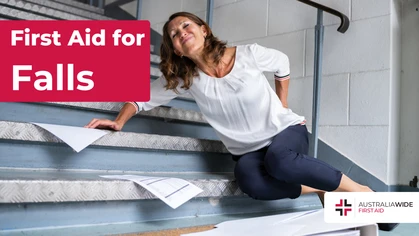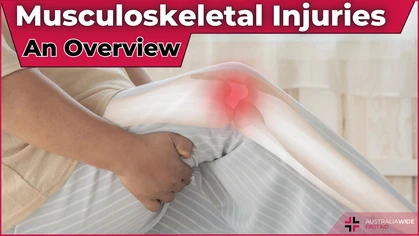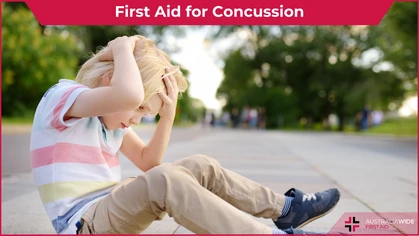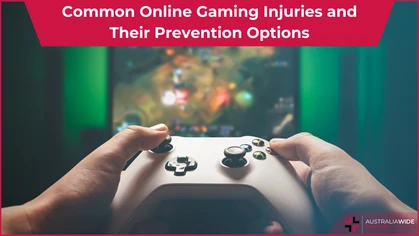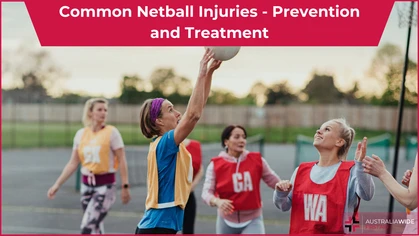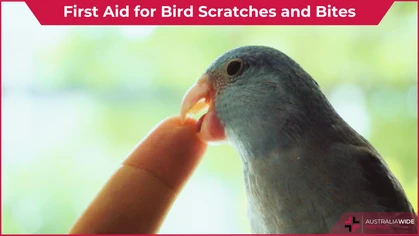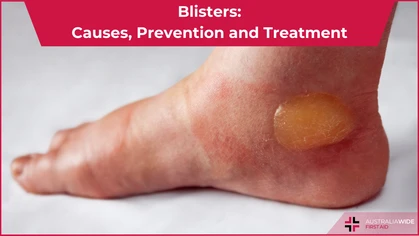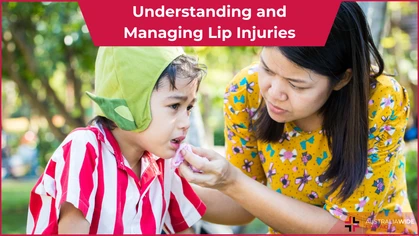Sunburn on Your Eyeballs

Injury
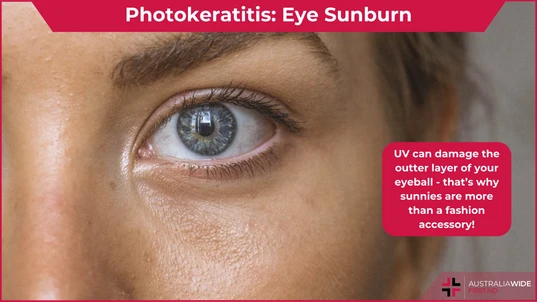 Australia can get notoriously hot, especially during the summer.
In the past year, this has caused the number of people seeking treatment for sun damage to increase by 28%. With heightened exposure to the sun’s harmful ultraviolet (UV) rays, the Cancer Institute in New South Wales reported that two in three Australians will be treated for skin cancer in their lifetime.
Yet the sun can affect more than just your skin. High levels of UV rays can also damage the cornea or the outermost layer of the eye. This can sometimes lead to photokeratitis.
Also known as eye sunburn, photokeratitis occurs when the eyes become overexposed to UV rays.
It's generally classified into two types: acute photokeratitis, which is the result of short-term exposure to high levels of UV light, and chronic photokeratitis, caused by exposure to low levels of UV light over time.
Photokeratitis is commonly a temporary condition, but its symptoms can be uncomfortable or even painful, and may lead to more serious eye problems if left unattended. Here’s what you need to know about photokeratitis and how you can protect your eyes from it.
Australia can get notoriously hot, especially during the summer.
In the past year, this has caused the number of people seeking treatment for sun damage to increase by 28%. With heightened exposure to the sun’s harmful ultraviolet (UV) rays, the Cancer Institute in New South Wales reported that two in three Australians will be treated for skin cancer in their lifetime.
Yet the sun can affect more than just your skin. High levels of UV rays can also damage the cornea or the outermost layer of the eye. This can sometimes lead to photokeratitis.
Also known as eye sunburn, photokeratitis occurs when the eyes become overexposed to UV rays.
It's generally classified into two types: acute photokeratitis, which is the result of short-term exposure to high levels of UV light, and chronic photokeratitis, caused by exposure to low levels of UV light over time.
Photokeratitis is commonly a temporary condition, but its symptoms can be uncomfortable or even painful, and may lead to more serious eye problems if left unattended. Here’s what you need to know about photokeratitis and how you can protect your eyes from it.
Symptoms of Eye Sunburn
Though they vary per person, symptoms of photokeratitis usually emerge 6 to 12 hours after being exposed to UV light. However, some people may experience them as early as 30 to 60 minutes after exposure. One of the first things you may experience is your eyes turning red. This occurs when blood vessels under the surface of the eyes become inflamed as a reaction to eye irritation from UV exposure. Your eyes may also become watery and painful. Eye pain is more serious than a mere irritation and usually occurs when you don’t wear protective eyewear in sunny or bright conditions. Overexposure to UV rays from the sun or other sources can also cause light sensitivity and blurry vision. However, you shouldn't neglect other minor symptoms that may also point to photokeratitis. This includes:- Headaches
- Inflammation
- Twitching eyelids
- A gritty sensation in the eyes
- Rare cases of temporary vision loss
- Changes in the colours you see

Red, irritated eyes can be a sign that you've not protected yourself adequately.
Causes of Eye Sunburn
The sun is the most common source of UV light, meaning photokeratitis is often caused by exposing yourself to direct sunlight outdoors without proper eye protection. UV rays that bounce off reflective surfaces like water, sand, and snow when frequenting spots like Whitehaven Beach or Falls Creek can also cause eye sunburn. That means you can experience this condition at any time of the year—not just in the summer. You're also at risk of photokeratitis if you visit places situated at higher elevations above sea level, like Perisher Valley or Cabramurra. Since the air thins as altitudes rise, the atmosphere absorbs less UV radiation. As a result, UV levels climb by 10-12% for every 1,000 metres increase in altitude. However, the sun isn't the only source of UV light you need to worry about. Lamps in tanning beds, laser lights, electric sparks from welding, halogen desk lamps, and UV wands used for disinfection can also cause overexposure and lead to photokeratitis.
Eyedrops can help ease symptoms.
Treatment for Eye Sunburn
Rest your eyes Upon experiencing symptoms, it’s best to immediately rest with your eyes closed. Closing your eyes encourages tear production, which can moisturise and clean the surface of your eyes, helping them recuperate and giving you relief. Avoid watching TV, looking at your phone, or any activity that can strain your eyes. You can also place a cold compress over them to provide comfort. Use artificial tears Artificial tears, also known as over-the-counter eye drops, can aid the recovery process by minimising eye strain and discomfort caused by photokeratitis. You can start by getting eye drops from brands like Systane and Murine to treat initial inflammation and dryness. However, a doctor’s advice may be necessary if symptoms persist after 48 hours. In this case, your optometrist may give you a prescription to buy antibiotic artificial tears that can treat infections, like Tobrex. Avoid rubbing your eyes Rubbing your eyes can increase the chances of corneal damage. Since photokeratitis exposes the corneal nerves, it could even result in unwanted consequences like eye infections if you don't clean your hands before you do so. To avoid further complications and damage, it’s best to avoid rubbing and touching your eyes altogether.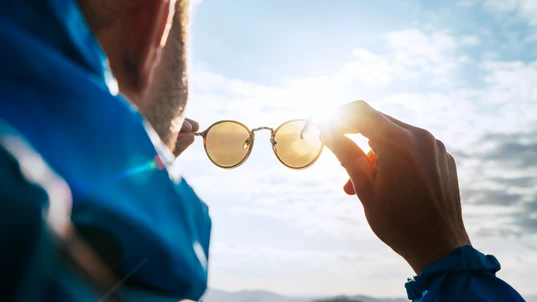
Sunnies are the perfect way to protect your eyes - even when it's cloudy!
Preventing Eye Sunburn
Wear sunglasses Sunglasses block harmful light from entering your eyes, thus limiting UV exposure. Given their efficacy, it's crucial to wear them outdoors year-round to prevent photokeratitis. However, not just any sunglasses will do. To provide the best protection for your eyes, you need to buy sunglasses from reliable brands. Companies like Oakley and Burberry specifically design sunglasses like the Frogskins and Ruth, which are specifically designed for outdoor use or come in wraparound and oversized designs to protect more of the eyes and the surrounding areas. More importantly, buying from a trusted source means they're guaranteed to comply with the Australian and New Zealand Sunglass Standards, which require sunglasses sold in the region to absorb almost all UV radiation. Wear sun hats Protective clothing like wide-brimmed sun hats will protect your face from the sun and provide additional shielding from UV light, especially when worn with sunglasses. So, if you’re hiking, going to the beach, or simply heading outside, be sure to put on extra protection by wearing a hat that can cover your eyes. For the best effect, be sure to buy one that's not just protective but also comfortable to wear. Sun hats like Filson's Summer Packer and Patagonia's Buggies Brimmer are a great place to start, as they're made of breathable fabric and won't fly off your head in windy conditions. Plan activities ahead If you wish to be more proactive, you can check if it's safe enough to go outdoors in the first place. Expanding weather results on places like your phone’s built-in weather app can show you the day’s UV Index. It will indicate if the UV Index is low (0 to 2), moderate (3 to 7), or extreme (8 above). If UV levels are moderate, it's time to don eye protection to prevent photokeratitis. You can also expect UV light to be at its highest between 10 in the morning and 3 in the afternoon. If you want to play golf or go to the beach, it may be best to adjust your schedule around this window to avoid UV overexposure. However, it's best to postpone the activities you have planned and stay indoors when UV levels are extreme.Conclusion
Photokeratitis is a temporary but painful condition. By becoming aware of its causes and keeping preventive measures in mind, you can avoid mistakes that put your eye health at risk.
Originally published at
https://www.australiawidefirstaid.com.au/resources/sunburn-on-your-eyeballs
as part of the Australia Wide First Aid Articles Library
